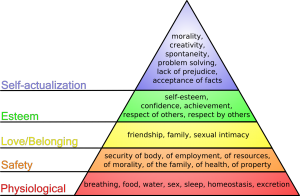Storytelling is the original social medium and humans are wired for it. As a marketer, storyteller, and improviser, I also believe it’s one of the most important, though underutilized, skills for leading today. And it’s not just about storytelling externally; it’s about rallying your best storytellers inside the company (read: not in the C-suite!) to become vocal, credible champions for your company’s message. Marketers today spend so much time on tactical messaging and not enough on the big strategic, human picture. What you stand for and the story of how you help people (you know, actual customers!) be better are central to a successful, differentiated marketing strategy.
Marketing Today Means Telling a Differentiated Company Story
Your company story is always bigger than your products and services. And, yes, the quality of products and services and the entire customer experience matters. However, companies with the best stories create perceived differentiation. Here are four ways to improve your company story in order to better connect with your audience and stand out over the long-haul.
1. Communicate your core purpose. Simon Sinek calls it the ‘Why’; I call it your core purpose. Whatever you call it, make sure it’s clear to your audience exactly what you care about and why you do what you do (read: not about profits). Yes, we’re in business to make profits and that happens as a result of a bigger why that serves peoples’ needs and makes lives better. Your “why” tells people your values and what you believe. Your products and services may reduce complexity, for example; this is your what. You may deliver via the cloud – that is your how. Neither are compelling unless we know WHY you do what you do. If your goal is transform finance leadership – that’s a bigger why that tells the audience what you value and why they should care. Too many companies forget that a common core purpose rallies your advocates – both internal and external – to your cause because it attracts people who believe what you believe. Employees and customers want to believe in something bigger than themselves; there is value in belonging to a movement (a great example is Toms Shoes). So, what’s your movement? Does your audience know? Do your employees know? They should, and most companies don’t spend the time trying to define this.
Moreover, a great core purpose serves as a strategic GPS, an unwavering true North, to guide decisions on how you allocate finite resources in rapidly changing times. It’s a filter for knowing what opportunities make sense. If an opportunity doesn’t advance the company’s core purpose, it doesn’t make sense to pursue. Find and articulate your core purpose story. It is the story from which all other company stories and strategies are derived, and the standard that gives other stories their credibility.
2. Communicate personal value for your customers. Yes, rational benefits matter. Most companies – especially in B2B – stop there. Research from Google and the Corporate Executive Board (CEB) shows that personal value has 2X the effect on outcomes (consideration, purchasing, etc) as rational value. It’s not just about meeting a professional need; it’s about helping your buyer meet a personal need. All buyers are motivated by a personal, human need: a need for security, reputation management and enhancement, visibility, mobility, social currency among peers, etc. Find that personal need and tell that story. In the CMO battle against commoditization, this is ground zero. That brings us to the next point.
3. Great stories are never about your products and services; they are about how your offerings make peoples’ lives better. How do you products make peoples’ lives better, easier, less complex? Tell *that* story of change. To the CFO of a public company, for example, your software better not just reduce the bottom line, it should protect HER bottom line by reducing her risk and helping her to run her organization better. Remember point number two: How do you make customers’ personal lives better? If your software enables customers to change their organizations for the better in meaningful qualitative ways, why focus on just the unemotional financial facts? These will be lost and, by the way, your competitors will claim similar results. Perceived differentiation cannot survive on mere financial facts alone. According to recent research at Stanford University (2013), stories are remembered up to 22X more than facts alone. In a world of increasing noise, facts are easily filtered.
4. Let your best people extend your narrative in a way that is meaningful to them. The best storytellers are often not in top management – they are the people on the front lines closest to the customer. According to Forrester research, 94% of buyers trust “people like me” and that not only refers to customer advocates, it applies to employees that aren’t part of the formal marketing funnel (and who don’t communicate in “corp-speak”). For example, IBM has more internal bloggers than any other large enterprise company of its size and that has added to the lifetime value of customers according to IBM estimates (and by a factor of 7X). Ford is another example of a company that features product teams talking about their passions, not just products. It’s a chance to see the people behind the products It’s human to human connection.
So humanize your story through the lens of your people. Yes, customer advocacy matters; however, if your employees can’t carry the torch for your company, your customers won’t be able to. Your people are stewards of the larger company story. The way they tell their stories should lend credibility to the larger company story.
How does your company tell a bigger, better story? Leave a comment below.




[…] Four Ways to Tell a Bigger and Differentiated Company Story […]